Table of contents of the article
Toggle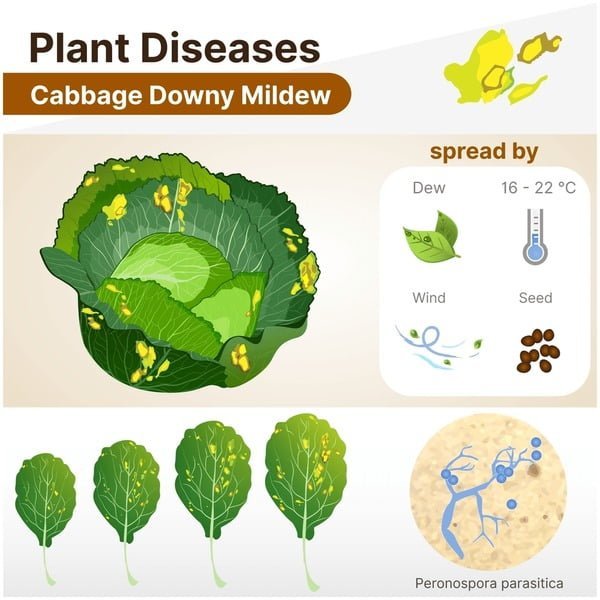
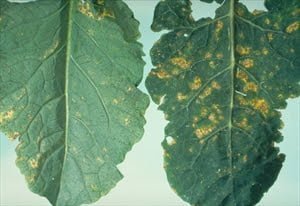
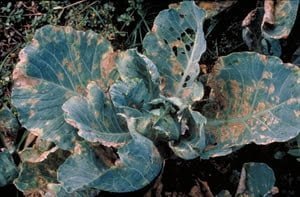
Powdery mildew disease in cabbage causes a white coating to appear on the leaves, which reduces the quality of the crop. In this article from “WORLD OF PLANTS”, we learn about prevention and treatment methods.
Definition of powdery mildew in cabbage
The common name is cabbage powdery mildew, and the scientific name is Hyaloperonospora parasiticus. It was formerly known as Peronospora parasitica. There are different strains of Oomycete so that the strain on radishes does not cause significant damage to cabbage.
Distribution – Asia, Africa, North, Central America, Caribbean, Europe, Oceania. Recorded from Australia, American Samoa, Fiji. French Polynesia, New Caledonia, New Zealand, Papua New Guinea, and Samoa.
Hosts – Members of the Brassica family, such as cabbage, broccoli, Chinese cabbage, and many others. It also infects weeds (such as shepherd's purse) and some ornamental plants (such as upholstery) in the Brassica family.
Symptoms and life cycle of powdery mildew in cabbage
This disease is caused by oomycete or water mold, not by fungi. Although they resemble fungi, powdery mildew is related to algae.
Attacks are more common in seed beds. Under humid conditions favorable to the disease, the yellow to pale brown spots quickly develop into large, irregular spots on the upper surface of young leaves. A greyish-white growth occurs on the underside of leaves, and may also be present on the upper surface during cool, wet conditions. Affected areas turn brown and papery in dry weather. Severely affected seedlings are stunted and killed. Older leaves may have a mottled appearance (Image 1).
Similar symptoms appear in the field and lead to early leaf death; In wet weather, the spots grow larger and cluster together and form large dead spots (Image 2). Infection can lead to bacterial rot in storage. Large dark brown rots develop on cabbage
Oomycete spreads in wind and water. Long-distance spread occurs on seedlings, and there is also evidence of spore spread on seeds. The disease appears best when there is high humidity, fog, heavy rain and heavy dew. Leaf moisture for 4-6 hours at 20°C and 6-8 hours at 15°C is necessary for significant infection and development of powdery mildew.
The oomycete survives on plants, as well as on weeds. Survival is also possible in soil and plant debris as thick-walled spores known as oospores, which are produced through a sexual process.
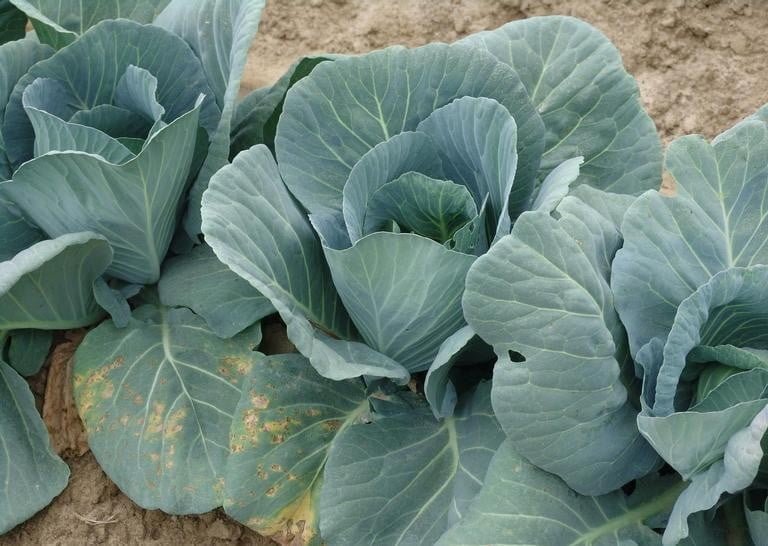
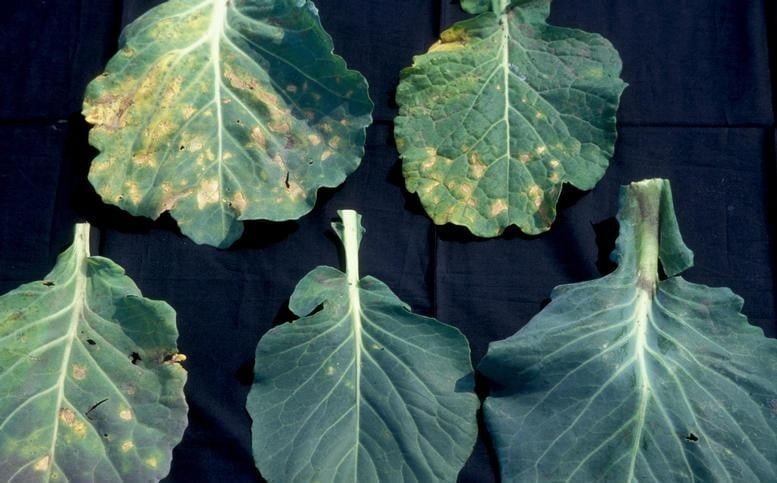
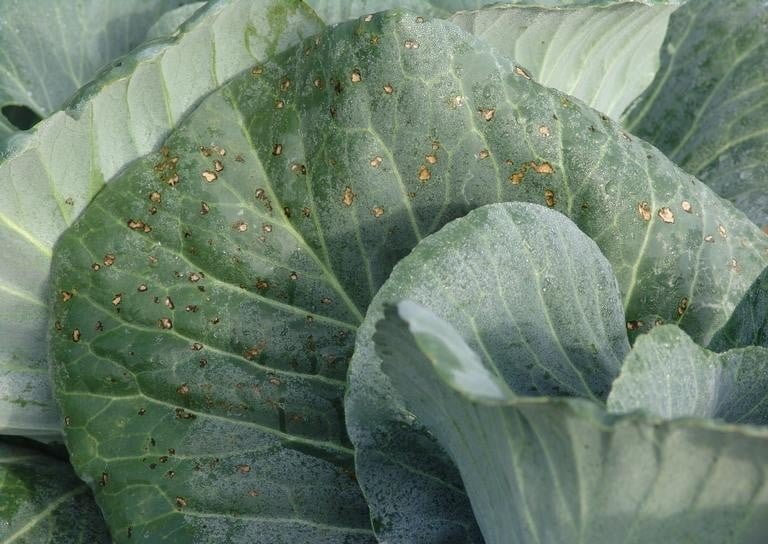
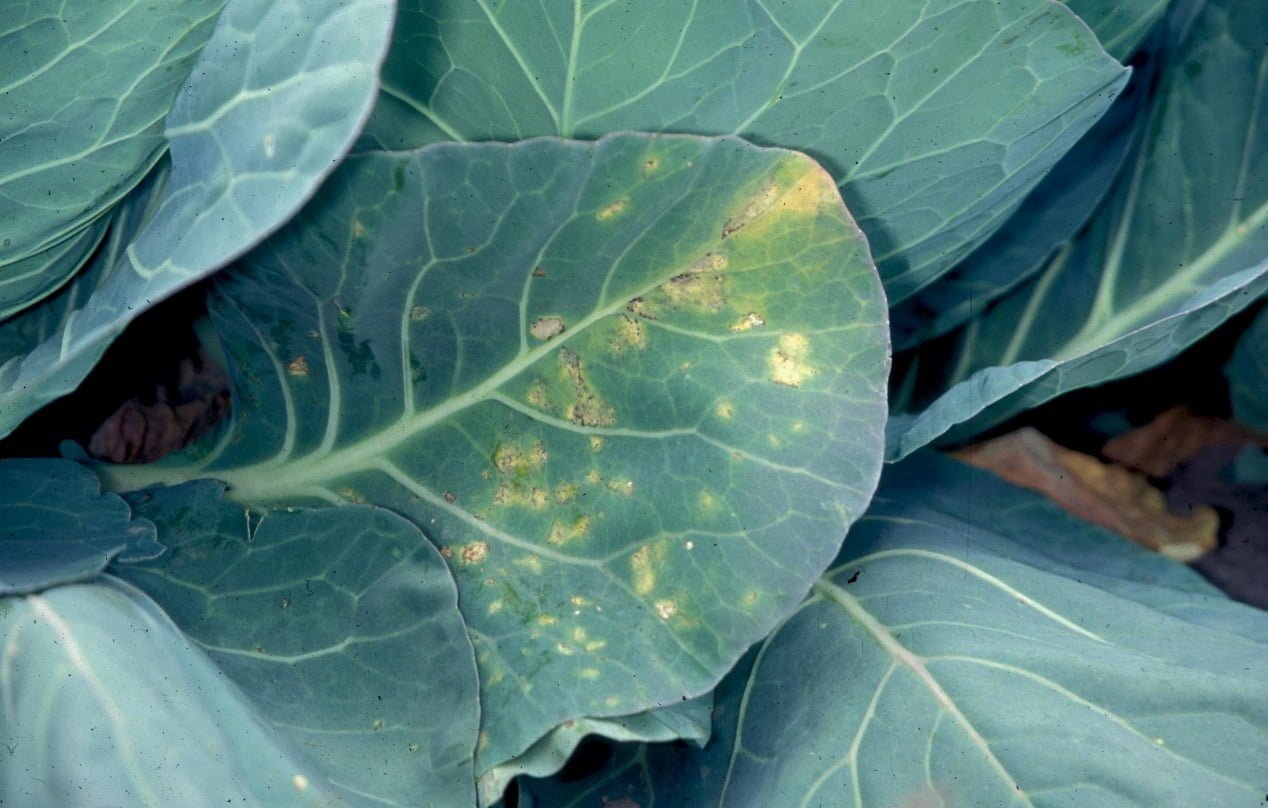
Effect of powdery mildew on cabbage
Powdery mildew of cabbage and other cabbage is not as important a disease in the tropics as it is in subtropical and temperate climates. Seedlings are usually affected by the disease, especially if they are overcrowded. Severely affected seedlings may die. Sometimes severe outbreaks are reported. Powdery mildew is more important on crops used for flower heads, such as broccoli and cauliflower, than those used for leaves, such as cabbage, and less harmful on those used for roots, such as kale.
Detection and inspection of powdery mildew in cabbage
Look for yellow spots on the shoots and young leaves, with white growths on the underside. Look for spore-bearing structures within the white growth using a hand lens.
1. Pre-planting control management
Keep nurseries free of weeds, especially those in the cabbage family.
Water the plants early in the day so that the leaves are only wet for a few hours, not enough time for powdery mildew spores to grow and infect them.
Avoid crowding the seedling until there is sufficient air movement around it.
Inspect each seedling carefully before planting it in the field, and remove any that show symptoms of powdery mildew. If symptoms appear, spray all seedlings with a systemic fungicide.
2. During growth
Remove weeds from the Brassica family that may be alternative hosts for powdery mildew.
3. After harvest
Practice crop rotation with non-Brassica species.
Collect and burn or bury as much of the crop as possible when harvest is complete.
4. Chemical control
Use fungicides on seedlings, but to increase their effect, keep humidity low and leaves moist (see above). If fungicides are needed, spray with systemic metalaxyl, protective mancozeb, copper or chlorothalonil.
When using an insecticide, always wear protective clothing and follow the instructions on the product label, such as dosage, timing of use, and pre-harvest period. Recommendations will vary depending on the crop and farming system. Expert advice on the most appropriate insecticides to use should always be sought from local agricultural authorities.
In conclusion, we would like to note that we, at the world of plants website, offer you all the necessary services in the world of plants, we provide all farmers and those interested in plants with three main services::-
- Artificial intelligence consulting service to help you identify diseases that affect plants and how to deal with them.
- Blog about plants, plant diseases and care of various crops ... You are currently browsing one of her articles right now.
- An application that provides agricultural consultations to clients, as well as a service for imaging diseases and knowing their treatment for free – Click to download the Android version from Google Play Store، Click to download the IOS version from the Apple App Store.
References
Author Graham Jackson
Image 1 Diseases of vegetable crops in Australia (2010). Editors, Dennis Persley, et al. CSIRO publication; And from CABI (2019) Hyaloperonospora parasitica (powdery mildew). Crop protection summary. (https://www.cabi.org/cpc/datasheet/39723). Image 2 Koehler F, et al. (1997) Diseases of crops grown in Pacific Island countries. South Pacific Commission. Perry Printers Pty Ltd, Canberra, Australia.
Produced with support from the Australian Center for International Agricultural Research under project PC/2010/090: Promoting integrated crop management research in the Pacific Islands to support the sustainable intensification of high-value crop production, implemented by the University of Queensland and the Pacific Community Secretariat.




